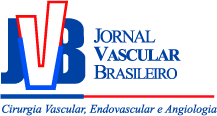Podemos atuar preventivamente para evitar que os pacientes portadores de COVID-19 evoluam de forma mais grave?
Can we manage prophylactic therapy in COVID-19 patients to prevent severe illness complications?
Paulo Eduardo Ocke Reis; Marcos Cesar Braga Lima
Resumo
Palavras-chave
Abstract
Many patients with COVID-19 have thromboembolic complications that worsen their prognosis. Herein, the authors propose a modified version of the CHA2 DS2 -VASc score, including 1 point for COVID-19, so that prophylaxis to protect against thromboembolic events would be indicated before the condition becomes severe. The advantages of this modification would be prevention of the patient’s condition worsening due to thromboembolic problems and reduction of the likelihood of a need for intensive care and mechanical ventilation, reducing mortality.
Keywords
References
1 Huang C, Wang Y, Li X, et al. Clinical features of patients infected with 2019 novel coronavirus in Whuam, China. Lancet. 2020;395(10223):497-506.
2 Casarna L, Sonzogni A, Nasr A, et al. Pulmonary post-mortem findings in a large series of COVID-19 cases from Northern Italy. medRxiv; 2020 [citado 2020 abr 28].
3 Obi AT, Barnes GD, Wakefield TW, et al. Practical diagnosis and treatment of suspected venous thromboembolism during COVID-19 Pandemic. J Vasc Surg Venous Lymphat Disord. 2020.
4 Cuffe R. Coronavírus: quais as chances de morrer por causa da covid-19. Brasil: BBC News; 2020 [citado 2020 abr 28].
5 Sá T, Sargento-Freitas J, Pinheiro V, et al. CHADS2 e CHA2DS2VASc como preditores de fonte cardioembólica em prevenção secundária cerebrovascular. Rev Port Cardiol. 2013;32(5):373-8.
6 Habboushe J, Altman C, Lip GYH. Time trends in use of the CHADS2 and CHA2 DS2 VASc scores, and the geographical and specialty uptake of these scores from a popular online clinical decision tool and medical reference. Int J Clin Pract. 2019;73(2):e13280.
7 Bikdeli B, Madhavan MV, Jimenez D, et al. COVID-19 and thrombotic or thromboembolic disease: implications for prevention, antithrombotic therapy, and follow-up. J Am Coll Cardiol. 2020;17:272-84. PMid:32311448.



